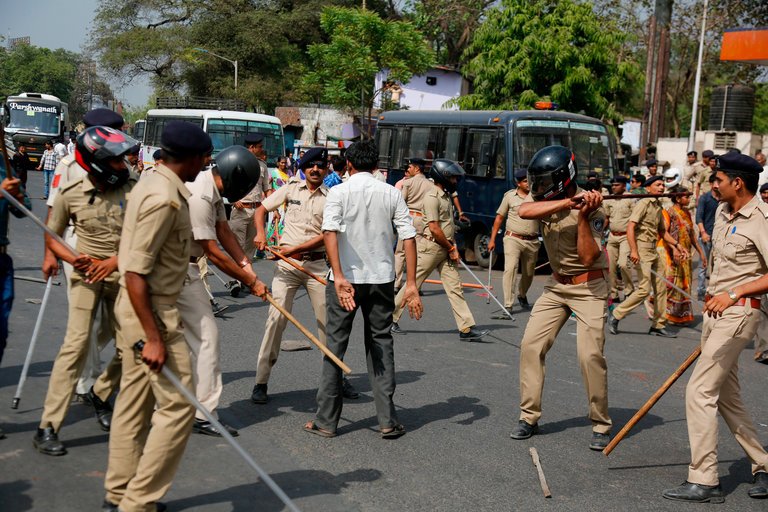Hundreds of thousands of India’s Dalits — once known as Untouchables — skipped work and poured into the streets this week, waving the dark blue flags of Dalit resistance. The protesters were connected through WhatsApp groups and fired up about a recent court ruling that many Dalits felt eroded some of their hard-fought gains. It soon turned ugly.
Young men barricaded railroad tracks, burned buses and hurled bricks at police officers. Caught off guard, the Indian authorities did what they often do. They sent phalanxes of club-wielding officers charging into the crowds. And in several states, they shut down the internet.
By the time the Dalit mutiny had been quelled, at least 11 people were dead — most of them Dalits. Dozens more were hurt, and hundreds were arrested.
The demonstrations showed two things. The Dalits, at perhaps 250 million strong (almost 20 percent of India’s population) will be a potent force in next year’s national elections. And their anger at India’s prime minister, Narendra Modi, and his governing party is growing.
INDIA’S WAY
India’s Boom Creates Openings for Untouchables DEC. 21, 2011
In recent decades, India’s historically disadvantaged Dalit community has made impressive strides in terms of economic prosperity. Just a generation ago, many people would move out of the way to avoid touching a Dalit. Some still do. But today there are Dalit millionaires.
Still, caste tensions lie just beneath the surface. And the Dalits’ anger at the Modi government has been simmering. Though Mr. Modi himself has been careful to court the Dalit vote by supporting a longstanding system of affirmative action for India’s lower castes, officials in his party have questioned this. There have also been some nasty crimes against Dalits by Hindu fanatics; often the government’s response has been less than outraged.
Dalit protesters in Chandigarh on Monday. The blue flags are a traditional sign of Dalit resistance. Credit Ajay Verma/Reuters
Dalit discrimination is not gently entombed in the past. In many parts of India, people still follow caste taboos, and often violently. Just last week, a mob of upper caste men in Gujarat hacked a young Dalit to death for riding a horse — lower caste people aren’t supposed to.
One website that writes about Dalit issues lists 116 forms of caste segregation still practiced. In many places, Dalit school children are forced to sit separately during lunchtime. And when it rains, Dalits are not supposed to use an umbrella in upper caste neighborhoods.
“Being a Dalit in India is like being on the battlefield,’’ said Dr. B. Karthik Navayan, a Dalit human rights activist. “Everyday and every minute you will be reminded of your lower caste position by language and actions and attacks.”
Dr. Navayan said a contentious ruling handed down by the Supreme Court last month was like “rubbing salt in a wound.’’
The case centered on an upper caste state employee in Maharashtra (the home state of Mumbai) who complained that he had been wrongly accused of caste discrimination by a lower caste worker. There’s an Indian law widely known as the Prevention of Atrocities Act that gives Dalits and other historically disadvantaged groups special protections from caste-based harassment or abuse.
India’s Supreme Court sided with the upper caste employee and ruled that there must be more guidelines in caste-based cases to protect the accused from being falsely prosecuted.
The conviction rate in caste-based cases is already paltry — about 25 percent, about half the overall conviction rate. That doesn’t surprise most Indians. In more traditional rural areas where Dalits are still much poorer than the other castes and socially ostracized, it’s very difficult for a Dalit to buck social pressures and pursue a charge against an upper-caste person.
Dalits blocking railway tracks in Allahabad on Monday. Credit Sanjay Kanojia/Agence France-Presse — Getty Images
And a surprising number of urban Indians admit they still adhere to caste taboos.
Lawyers said getting justice for Dalits will now be even harder, because the Supreme Court’s decision adds more layers of scrutiny.
“The perpetrators will make good use of these technicalities,’’ said Kishore Narayana, a lawyer in the city of Bilaspur.
Newsletter Sign UpContinue reading the main story
The Interpreter Newsletter
Understand the world with sharp insight and commentary on the major news stories of the week.
Dalit activists were incensed, and last week, using WhatsApp and other social media, they put out a call for a nationwide strike. As Indians have witnessed before, divisive news that can have real consequences crossed their country at lightspeed.
The protests quickly took an antigovernment bent, even though Mr. Modi’s political party had actually spoken out against the case — perhaps not as early or as loudly as it could have, but it was on the record opposing any change to the law.
That did not seem to matter. Rumors quickly spread that Mr. Modi might do away with caste reservations, the affirmative action policy that Dalits fiercely guard because it has given them a leg up in university admissions and government jobs.
The leading opposition party, the Indian National Congress, wasn’t going to miss an opportunity. Congress usually does well among Dalits. But in recent years, Mr. Modi has used his considerable charisma and strong political organization to peel off some Dalit votes.
With protests looming, Rahul Gandhi, Congress’s leader, tweeted that it was in the DNA of Mr. Modi’s party to “keep the Dalits in the lowest rung of Indian society.’’
Mr. Modi’s government announced it would petition the Supreme Court to review the case. But the government stepped in only after the protests had started and several Dalits had been killed.

